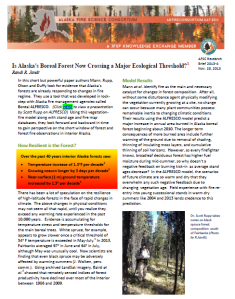It’s hard to say what impact the recession of permafrost in the northern half of Alaska will have on fire regime. One could presume there should be more organic moss and duff material available for combustion during the summer, which is likely to have implications for tundra fire extent and severity. Warmer permafrost has also been linked to more extensive retrogressive thaw slumps–a kind of thermokarst which have been seen after tundra fire in ice-rich areas (photo). If you can make it, Dr. Romanovsky’s talk “Evidence of recent warming and thawing of permafrost in the Arctic and sub-Arctic,“ with updates on his extensive grid of permafrost monitoring wells up and down Alaska should be very interesting. The talk is Oct 23 at Elvey Auditorium, University of Alaska-Fairbanks, at 4 pm ADT.
Tag Archives: permafrost
Research Brief: Is Alaska’s Forest Crossing a Threshold?
Is Alaska’s Boreal Forest Now Crossing a Major Ecological Threshold?:  Read up on what Alaskan forest and climate research has found out about the influence of warming climate on boreal forests in the Interior! Here’s a new 2-page Research Brief that digests one of the more significant papers on forest and climate change. The authors– Dan Mann, Scott Rupp, Mark Olson and Paul Duffy– are well-known to Alaska fire managers. This is a good basis to our upcoming focus on multi-faceted influences of dynamic climate on fire regime, forests, and fire management in Alaska in 2014!
Read up on what Alaskan forest and climate research has found out about the influence of warming climate on boreal forests in the Interior! Here’s a new 2-page Research Brief that digests one of the more significant papers on forest and climate change. The authors– Dan Mann, Scott Rupp, Mark Olson and Paul Duffy– are well-known to Alaska fire managers. This is a good basis to our upcoming focus on multi-faceted influences of dynamic climate on fire regime, forests, and fire management in Alaska in 2014!
Read More >> | Download PDF (861 kb)
Climate, Fire, Frost and the Carbon Bank Research Brief
Climate, Fire, Frost and the Carbon Bank: This 2-page research brief summarizes several years of field studies–citing recently published articles–by USGS soil scientists Jennifer Harden and Kristen Manies. Their studies shed new light on the impact of fires on permafrost in Alaska boreal forest, and interactions of fire effects and freezing effects on the forest floor. The insulating moss/duff layer plays a critical role in protecting permafrost and conditions suitable for the rapid regrowth of permafrost are keys to determining whether boreal forest will retain its ability to store large amounts of biomass carbon. Read More >> | Download PDF (1.5 Mb)


